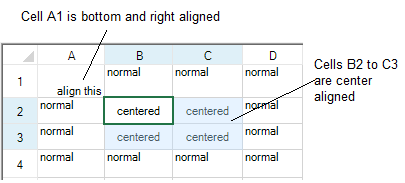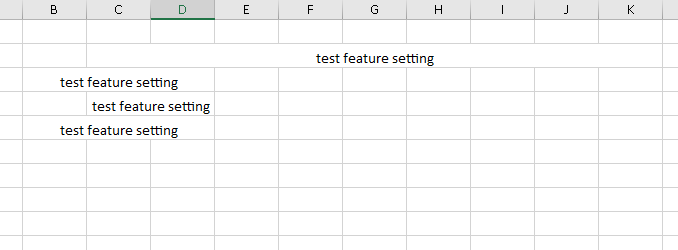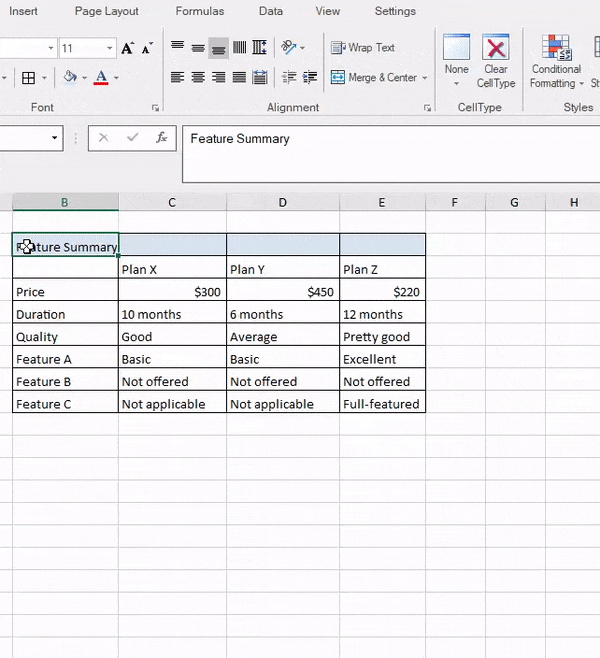-
Spread Windows Forms Product Documentation
- Getting Started
-
Developer's Guide
- Understanding the Product
- Working with the Component
- Spreadsheet Objects
- Ribbon Control
- Sheets
- Rows and Columns
- Headers
-
Cells
- Working with the Active Cell
- Adding Hyperlink in a Cell
- Creating a Range of Cells
- Managing Data on a Sheet
- Displaying Cell Data
- Creating a Span of Cells
- Allowing Cells to Merge Automatically
- Adding a Note to a Cell
- Adding a Tag to a Cell
- Displaying Text Tips in a Cell
- Working with Cell Format Strings
- Working with Pattern and Gradient Fill Effects
- Inserting Cells
- Setting Rich Text in a Cell
- Adding a Comment to a Cell
- Adding Image in a Cell
- Formatting a Cell Value
- Cell Types
- Data Binding
- Customizing the Sheet Appearance
- Customizing Interaction in Cells
- Tables
- Understanding the Underlying Models
- Customizing Row or Column Interaction
- Formulas in Cells
- Sparklines
- Keyboard Interaction
- Events from User Actions
- File Operations
- Storing Excel Summary and View
- Printing
- Chart Control
- Customizing Drawing
- Touch Support with the Component
- Spread Designer Guide
- Assembly Reference
- Import and Export Reference
- Version Comparison Reference
Aligning Cell Contents
You can determine how the contents are aligned in a cell or in a group of cells. In code, simply set the HorizontalAlignment property and the VerticalAlignment properties, and make use of the CellHorizontalAlignment and CellVerticalAlignment enumerations. In the Spread Designer, set those properties accordingly. The following figure shows the result of the code in the first example.

There are additional properties in the Cell class such as TextIndent and CellPadding that can be used to create extra margins around cell text.
For an explanation of how the alignment affects the overflow of data, refer to Allowing Cell Data to Overflow
You can keep the cell alignment when editing with the AllowEditorVerticalAlign property.
Using the Properties Window
At design time, in the Properties window, select the Spread component.
Select the Sheets property.
Click the button to display the SheetView Collection Editor.
In the Members list, select the sheet in which the cells appear.
In the properties list, select the Cells property and then click the button to display the Cell, Column, and Row Editor.
Select the cells for which you want to set the alignment.
In the properties list, select the HorizontalAlignment property and choose the alignment.
To set the vertical alignment, select the VerticalAlignment property in the properties list and choose the alignment.
Click OK to close the Cell, Column, and Row Editor.
Click OK to close the SheetView Collection Editor.
Using a Shortcut
Set the HorizontalAlignment property and the VerticalAlignment properties for the Cells shortcut object.
Example
This example code sets the horizontal alignment of the first cell (A1) to be right-aligned, the vertical alignment of that cell to be bottom-aligned, and the horizontal alignment and vertical alignment of cells from B2 to C3 to be centered. The preceding figure illustrates the results.
fpSpread1.Sheets[0].Cells[0,0].HorizontalAlignment = FarPoint.Win.Spread.CellHorizontalAlignment.Right;
fpSpread1.Sheets[0].Cells[0,0].VerticalAlignment = FarPoint.Win.Spread.CellVerticalAlignment.Bottom;
fpSpread1.Sheets[0].Cells[1,1,2,2].HorizontalAlignment = FarPoint.Win.Spread.CellHorizontalAlignment.Center;
fpSpread1.Sheets[0].Cells[1,1,2,2].VerticalAlignment = FarPoint.Win.Spread.CellVerticalAlignment.Center;FpSpread1.Sheets(0).Cells(0,0).HorizontalAlignment = FarPoint.Win.Spread.CellHorizontalAlignment.Right
FpSpread1.Sheets(0).Cells(0,0).VerticalAlignment = FarPoint.Win.Spread.CellVerticalAlignment.Bottom
FpSpread1.Sheets(0).Cells(1,1,2,2).HorizontalAlignment = FarPoint.Win.Spread.CellHorizontalAlignment.Center
fpSpread1.Sheets(0).Cells(1,1,2,2).VerticalAlignment = FarPoint.Win.Spread.CellVerticalAlignment.CenterUsing Code
Set the HorizontalAlignment property and the VerticalAlignment properties for the Cell object.
Example
This example code sets the horizontal alignment for a specific cell and the vertical alignment for a range of cells.
FarPoint.Win.Spread.Cell cellA1;
cellA1 = fpSpread1.ActiveSheet.Cells[0, 0];
cellA1.HorizontalAlignment = FarPoint.Win.Spread.CellHorizontalAlignment.Right;
cellA1.VerticalAlignment = FarPoint.Win.Spread.CellVerticalAlignment.Bottom;
FarPoint.Win.Spread.Cell cellrange;
cellrange = fpSpread1.ActiveSheet.Cells[1,1,2,2];
cellrange.HorizontalAlignment = FarPoint.Win.Spread.CellHorizontalAlignment.Center;
cellrange.VerticalAlignment = FarPoint.Win.Spread.CellVerticalAlignment.Center;Dim cellA1 As FarPoint.Win.Spread.Cell
cellA1 = FpSpread1.ActiveSheet.Cells(0, 0)
cellA1.HorizontalAlignment = FarPoint.Win.Spread.CellHorizontalAlignment.Right
cellA1.VerticalAlignment = FarPoint.Win.Spread.CellVerticalAlignment.Bottom
Dim cellrange As FarPoint.Win.Spread.Cell
cellrange = FpSpread1.ActiveSheet.Cells(1, 1, 2, 2)
cellrange.HorizontalAlignment = FarPoint.Win.Spread.CellHorizontalAlignment.Center
cellrange.VerticalAlignment = FarPoint.Win.Spread.CellVerticalAlignment.CenterUsing the Spread Designer
In the work area, select the cell or cells for which you want to set the horizontal alignment of the cell contents.
In the properties list (in the Misc category), select the HorizontalAlignment property.
Click the drop-down button to display the choices and choose the alignment.
Repeat these steps and in the properties list, select VerticalAlignment to set the vertical alignment of the cell or cells.
From the File menu choose Apply and Exit to apply your changes to the component and exit Spread Designer.
Center Across Selection
You can center-align the contents of the selected cells across columns without merging the cells. This type of horizontal alignment can be set using the HorizontalAlignment.CenterAcrossSelection enumeration option from the GrapeCity.Spreadsheet namespace.
In order to implement the CenterAcrossSelection alignment option, the AllowCellOverflow property of FpSpread class must be set to true and the BorderCollapse property must be set to ‘Enhanced’.

This example code sets the center across selection for cells:
fpSpread1.AllowCellOverflow = true;
fpSpread1.BorderCollapse = BorderCollapse.Enhanced;
IWorksheet TestActiveSheet = fpSpread1.AsWorkbook().ActiveSheet;
TestActiveSheet.Cells["C2"].Text = "test feature setting";
TestActiveSheet.Cells["C2:K2"].HorizontalAlignment = GrapeCity.Spreadsheet.HorizontalAlignment.CenterAcrossSelection;//set for big range
TestActiveSheet.Cells["C3"].Text = "test feature setting";
TestActiveSheet.Cells["C3"].HorizontalAlignment = GrapeCity.Spreadsheet.HorizontalAlignment.CenterAcrossSelection;//set for 1 cell
TestActiveSheet.Cells["C4"].Text = "test feature setting";
TestActiveSheet.Cells["C4:D4"].HorizontalAlignment = GrapeCity.Spreadsheet.HorizontalAlignment.CenterAcrossSelection;//set for small range start from data cell
TestActiveSheet.Cells["C5"].Text = "test feature setting";
TestActiveSheet.Cells["B5:C5"].HorizontalAlignment = GrapeCity.Spreadsheet.HorizontalAlignment.CenterAcrossSelection;//set for small range end by data cell
FarPoint.Win.Spread.Dialogs.BuiltInDialogs.FormatCells(TestActiveSheet.Cells["A1:D5"]).ShowDialog();FpSpread1.AllowCellOverflow = True
FpSpread1.BorderCollapse = BorderCollapse.Enhanced
IWorksheet TestActiveSheet = FpSpread1.AsWorkbook().ActiveSheet
TestActiveSheet.Cells("C2").Text = "test feature setting"
TestActiveSheet.Cells("C2:K2").HorizontalAlignment = GrapeCity.Spreadsheet.HorizontalAlignment.CenterAcrossSelection ' set for big range
TestActiveSheet.Cells("C3").Text = "test feature setting"
TestActiveSheet.Cells("C3").HorizontalAlignment = GrapeCity.Spreadsheet.HorizontalAlignment.CenterAcrossSelection ' set for 1 cell
TestActiveSheet.Cells("C4").Text = "test feature setting"
TestActiveSheet.Cells("C4:D4").HorizontalAlignment = GrapeCity.Spreadsheet.HorizontalAlignment.CenterAcrossSelection ' set for small range start from data cell
TestActiveSheet.Cells("C5").Text = "test feature setting"
TestActiveSheet.Cells("B5:C5").HorizontalAlignment = GrapeCity.Spreadsheet.HorizontalAlignment.CenterAcrossSelection ' set for small range end by data cell
FarPoint.Win.Spread.Dialogs.BuiltInDialogs.FormatCells(TestActiveSheet.Cells("A1:D5")).ShowDialog()Using the Spread Designer
In the work area, select the range of cells for which you want to set the center across selection.
Select the Spread option from the selected item list of the properties window.
Select the BorderCollapse property from the properties list of the Appearance category. Set the property to Enhanced.
Select the AllowCellOverflow property from the properties list of the Behavior category and set it to true.
Click the Dialog Box Launcher arrow at the bottom right corner of the Alignment group of Home menu. This opens the Format Cells dialog.

Select the Center Across Selection from the dropdown list of the Horizontal option of Alignment tab in the dialog.
Click OK to apply the changes.
See Also
Resizing the Data to Fit the Cell


